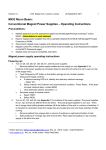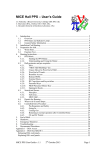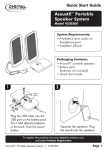Download Luminosity Monitor Operating Instructions
Transcript
L. Coney V1.2 30 September 2010 Luminosity Monitor Operating Instructions The Luminosity Monitor is simple to operate, but care must be taken not to damage the photomultiplier tubes (PMTs). Turning on the PMTs: • • • The four PMTs are powered by two low voltage power supplies in the front electronic rack behind the target control rack in the MICE rack room next to the MLCR. These power supplies should be ramped up manually from 0V to the voltages in Table 1. NEVER EXCEED 15 V or you may damage the PMTs! Photomultiplier Number Low Voltage Supply (V) PMT-1 10.5 PMT-2 10.7 PMT-3 10.7 PMT-4 10.5 Table 1. Low voltage settings for the four Luminosity Monitor PMTs. The Luminosity Monitor PMTs should always remain on except for maintenance or repair. Turning OFF the PMTs: • • • Gently ramp down each tube to 0 V before turning off the power supply. DO NOT just turn off the power supply. NOTE: When turning them back on, ensure they start from 0V. Luminosity Monitor Signal Processing: • • • • • • Four individual signals arrive on a patch panel under the NIM crate that houses the electronics. These signals are fed to four LeCroy 428F Fan in/out units to duplicate signals and are then fed to discriminators (LeCroy 628B octal discriminator) set to 500 mV. The discriminator level for each channel can be checked with a multimeter on the LeCroy unit. The voltage level is 10 times larger than the actual value (ie. For a 500 mV discriminator level, the multimeter will read 5 V). The discriminator output signals are set to a width of 10 ns (this could change in future). The discriminator signals are gated and synchronized with the MICE Spill Gate (which typically fires for the last 3.23 ms of an ISIS spill). Individual signals are then fed to a LeCroy 622 quad coincidence unit. L. Coney V1.2 • • • • • 30 September 2010 Signals 1 and 2 form the first coincidence (LMC-12) and signals 3 and 4 form the second coincidence (LMC-34). LMC-12 and LMC-34 are then fed to a third coincidence unit to form the four-fold coincidence LMC-1234. All signals from the coincidence unit are also 20 ns wide. The coincidence signals are then fed to the patch panel which is connected via cables under the floorboards to another patch panel in the second row of electronic racks where the VME units can be found. Signals LMC-12, LMC-34, and LMC-1234 are connected to a NIMECL converter that feeds them into one of the CAEN VME scaler units (model V830) which are recorded to disk during data-taking. • SCALER Channels 8, 9, and 10 are LMC-12, LMC34, and LMC-1234 respectively and can be seen using the Online Monitoring. • The coincidence values can also be seen on the monitor in the rack room under the scope.












